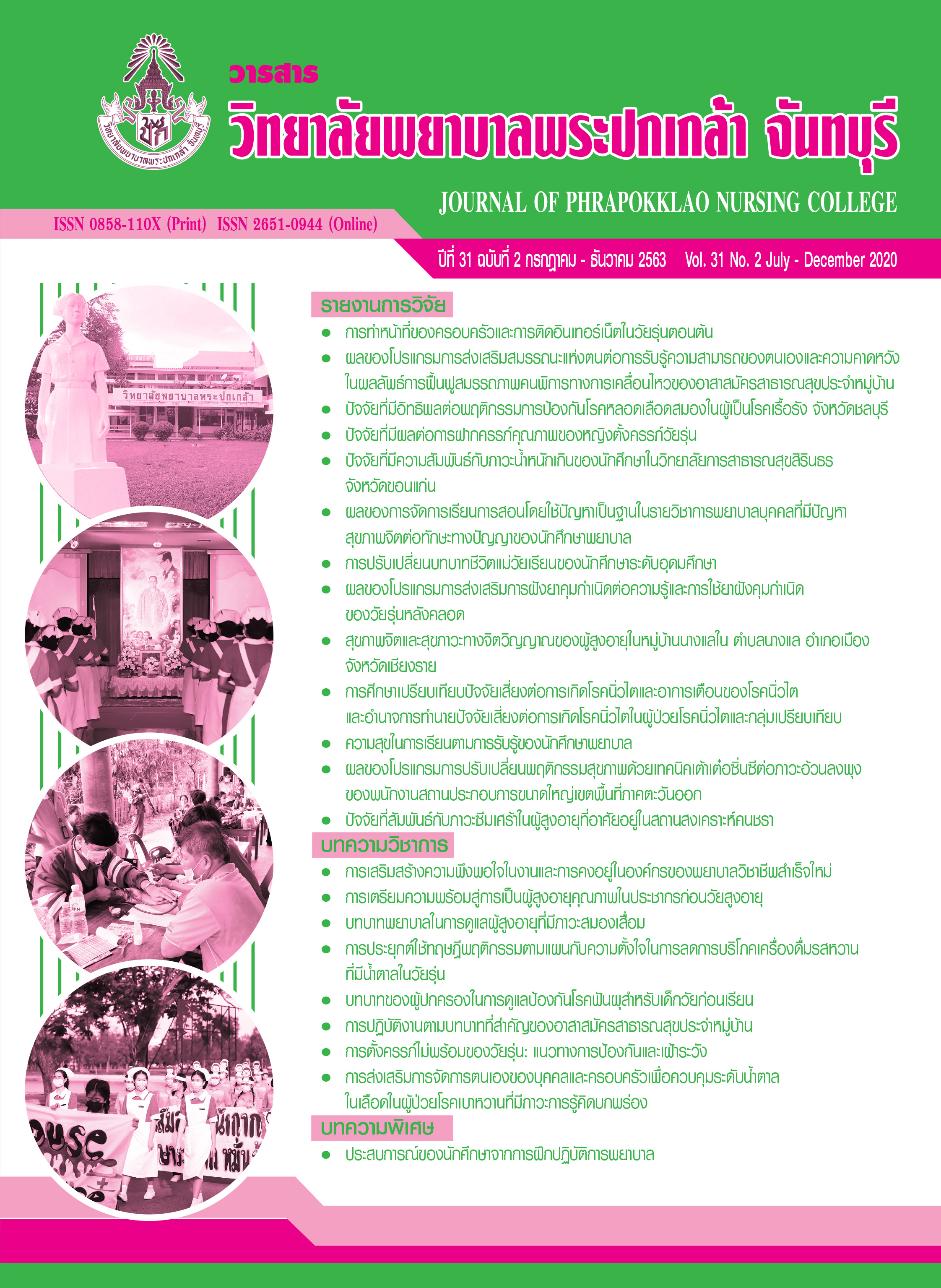Factors Related to Depression in Older Adults Living in Nursing Home
Keywords:
Depression, Older adults in nursing homeAbstract
This descriptive correlational research aimed to investigate relationships of age, duration of stay in nursing home, activity of daily living, sense of belonging, and social support with depression of older adults. The participants consisted of 100 older adults living in government nursing home in the eastern of Thailand. The research instruments comprised the Set Test, the personal data questionnaire, Barthel Activity of Daily Living Index: Thai version with the reliability of .74, the Sense of Belonging Instrument, Psychological with the reliability of .63, Multi-dimensional Scale of Perceived Social Support Thai version with the reliability of .74, and Thai Geriatric Depression Scale: Short version with the reliability of .83. Data were collected from February to March, 2018. Statistics used for data analysis included frequency, percentage, mean, standard deviation, and Spearman rank correlation.
The research results revealed that the factors that negatively statistically significant related to depression were activity of daily living (rs = -.200, p < .05), sense of belonging (rs = -.702, p < .001), and social support (rs = -.460, p < .001).
This research suggests that personnel who care for older adults living in nursing home should provide activities that promote sense of belonging as well as give social support according to the needs of older adults.
References
ธนัญพร พรมจันทร์. (2556). ภาวะซึมเศร้า ความว้าเหว่ และการเห็นคุณค่าในตนเองของผู้สูงอายุที่พักอาศัยในสถานสงเคราะห์คนชราบ้านบางแค และที่พักผู้สูงอายุของเอกชนในเขตกรุงเทพมหานคร (วิทยานิพนธ์ปริญญามหาบัณฑิต). กรุงเทพฯ: จุฬาลงกรณ์มหาวิทยาลัย.
นิภาพร พุ่มซ้อน, และสุธิดา สิงหสุต. (2552). วิถีชีวิตผู้สูงอายุในสถานสงเคราะห์คนชราบ้านบางแค 2 (สารนิพนธ์ปริญญาบัณฑิต). เพชรบุรี: มหาวิทยาลัยศิลปากร.
เนตรนภา จัตุรงค์แสง. (2540). การเปรียบเทียบอัตมโนทัศน์และความซึมเศร้าของผู้สูงอายุที่อาศัยอยู่ภายในและภายนอกสถานสงเคราะห์คนชรา (วิทยานิพนธ์ปริญญามหาบัณฑิต). นครปฐม: มหาวิทยาลัยมหิดล.
ผจงจิต ไกรถาวร, และนพวรรณ เปียซื่อ. (2556). ความรู้สึกเป็นส่วนหนึ่งของชุมชนและการรับรู้สภาพสิ่งแวดล้อมละแวกบ้านของผู้สูงอายุไทยที่อาศัยอยู่ในชุมชนแออัด เขตกรุงเทพมหานคร. รามาธิบดีพยาบาลสาร, 19(1), 143–156.
มูลนิธิสถาบันวิจัยและพัฒนาผู้สูงอายุไทย และสถาบันวิจัยประชากรและสังคม มหาวิทยาลัยมหิดล. (2558). สถานการณ์ผู้สูงอายุไทย พ.ศ. 2557. กรุงเทพฯ: อมรินทร์พริ้นติ้งแอนด์พับลิชชิ่ง.
รสพร เพียรรุ่งเรือง, และพีรพนธ์ ลือบุญธวัชชัย. (2558). ปัญหาสัมพันธภาพระหว่างบุคคลและภาวะซึมเศร้าของผู้สูงอายุในชมรมผู้สูงอายุ จังหวัดพิษณุโลก. วารสารสมาคมจิตแพทย์แห่งประเทศไทย, 60(1), 23–34.
วิชัย เอกพลากร. (2557). รายงานการสำรวจสุขภาพประชาชนไทยโดยการตรวจร่างกาย ครั้งที่ 5 พ.ศ. 2557. นนทบุรี: สถาบันวิจัยระบบสาธารณสุข.
ศิริรำไพ สุวัฒนคุปต์. (2555). การศึกษาเปรียบเทียบภาวะซึมเศร้าของผู้สูงอายุที่อยู่ในบ้านพักของตนเองและผู้สูงอายุที่อยู่ในบ้านพักคนชรา อำเภอเมือง จังหวัดเชียงใหม่ (วิทยานิพนธ์ปริญญามหาบัณฑิต). กรุงเทพฯ: จุฬาลงกรณ์มหาวิทยาลัย.
สมหมาย กุมผัน. (2558). ปัจจัยที่มีอิทธิพลต่อความว้าเหว่ในผู้สูงอายุ (วิทยานิพนธ์ปริญญามหาบัณฑิต). กรุงเทพฯ: มหาวิทยาลัยมหิดล.
สมใจ โชติธนพันธุ์. (2550). การศึกษาความสัมพันธ์ระหว่างการสนับสนุนทางสังคมกับภาวะซึมเศร้าของผู้สูงอายุในสถานสงเคราะห์ผู้สูงอายุบ้านบางแค (สารนิพนธ์ปริญญามหาบัณฑิต). กรุงเทพฯ: มหาวิทยาลัยศรีนครินทรวิโรฒ.
สุทธิชัย จิตะพันธ์กุล. (2544). หลักสำคัญของเวชศาสตร์ผู้สูงอายุ (พิมพ์ครั้งที่ 3). กรุงเทพฯ: โรงพิมพ์แห่งจุฬาลงกรณ์มหาวิทยาลัย.
อัมภัสชา พานิชชอบ. (2546). การศึกษาคุณภาพชีวิตของผู้สูงอายุในสถานสงเคราะห์คนชราบ้านบางแค และสถานที่พักผู้สูงอายุเอกชนในกรุงเทพมหานครและปริมณฑล (วิทยานิพนธ์ปริญญามหาบัณฑิต). กรุงเทพฯ: จุฬาลงกรณ์มหาวิทยาลัย.
Bailey, M., & McLaren, S. (2005). Physical activity alone and with others as predictors of sense of belonging and mental health in retirees. Aging & Mental Health, 9(1), 82–90.
Cohen, J. (1988). Statistical power analysis for the behavioral sciences (2nd ed.). Hillsdale, NJ: Lawrence Erlbaum Associates.
Eliopoulos, C. (2010). Gerontological nursing (7th ed.). Philadelphia: Wolters Kluwer Health/Lippincott Williams & Wilkins.
Hagerty, B. M., Lynch-Sauer, J., Patusky, K. L., Bouwsema, M., & Collier, P. (1992). Sense of belonging: A vital mental health concept. Archives of Psychiatric Nursing, 6(3), 172–177.
Hagerty, B. M., & Williams, R. A. (1999). The effects of sense of belonging, social support, conflict, and loneliness on depression. Nursing Research, 48(4), 215–219.
House, J. S., Umberson, D., & Landis, K. R. (1988). Structures and processes of social support. Annual Review of Sociology, 14(1), 293–318.
Isaacs, B., & Kennie, A. T. (1973). The set test as an aid to the detection of dementia in old people. British Journal of Psychiatry, 123(575), 467–470.
Lin, P. C., Wang, H. H., & Huang, H. T. (2007). Depressive symptoms among older residents at nursing homes in Taiwan. Journal of Clinical Nursing, 16(9), 1719–1725.
Llewellyn-Jones, R. H., & Snowdon, J. A. (2007). Depression in nursing homes: Ensuring adequate treatment. CNS Drugs, 21(8), 627–640.
Majerovitz, S. D. (2007). Predictors of burden and depression among nursing home family caregivers. Aging & Mental Health, 11(3), 323–329.
Malfent, D., Wondrak, T., Kapusta, N. D., & Sonneck, G. (2010). Suicidal ideation and its correlates among elderly in residential care homes. International Journal of Geriatric Psychiatry, 25(8), 843–849.
Sangon, S. (2001). Predictor of depression in Thai women (Doctoral dissertation). Ann Arbor: University of Michigan.
Tiong, W. W., Yap, P., Huat Koh, G. C., Phoon, F. N., & Luo, N. (2013). Prevalence and risk factors of depression in the elderly nursing home residents in Singapore. Aging & Mental Health, 17(6), 724–731.
Tsai, Y. F., Yeh, S. H., & Tsai, H. H. (2005). Prevalence and risk factors for depressive symptoms among community-dwelling elders in Taiwan. International Journal of Geriatric Psychiatry, 20(11), 1097–1102.
Tu, Y. Y., Lai, Y. L., Shin, S. C., Chang, H. J., & Li, L. (2012). Factors associated with depressive mood in the elderly residing at the long-term care facilities. International Journal of Gerontology, 6(1), 5–10.
Wongpakaran, N., Wongpakaran, T., & Reekum, R. V. (2013). The use of GDS-15 in detecting MDD: A comparison between residents in a Thai long-term care home and geriatric outpatients. Journal of Clinical Medicine Research, 5(2), 101–111.
Wongpakaran, T., Wongpakaran, N., & Ruktrakul, R. (2011). Reliability and validity of the Multidimensional Scale of Perceived Social Support (MSPSS): Thai Version. Clinical Practice Epidemiology in Mental Health, 7(1), 161–166.
World Health Organization. (2017). Mental health and older adults. Retrieved from http://www.who.int/mediacentre/factsheets/fs381/en/
Yeung, D. Y., Kwok, S. Y., & Chung, A. (2012). Institutional peer support mediates the impact of physical declines on depressive symptoms of nursing home residents. Journal of Advanced Nursing, 69(4), 875–885.
Zammit, P., & Fiorini, A. (2015). Depressive illness in institutionalised older people in Malta. Malta Medical Journal, 27(3), 22–25.
Zimet, G. D., Dahlem, N. W., Zimet, S. G., & Farley, G. K. (1988). The multidimensional scale of perceived social support. Journal of Personality Assessment, 52(1), 30–41.
Zivin, K., Wharton, T., & Rostant, O. (2013). The economic, public health and caregiver burden of late-life depression. Psychiatric Clinics of North America, 36(4), 631–649.
Downloads
Published
How to Cite
Issue
Section
License
Copyright (c) 2020 JOURNAL OF PHRAPOKKLAO NURSING COLLEGE

This work is licensed under a Creative Commons Attribution-NonCommercial-NoDerivatives 4.0 International License.
เนื้อความ ข้อมูล และรายการอ้างอิงที่ผู้เขียนใช้ในการเขียนบทความเพื่อลงตีพิมพ์ในวารสารวิทยาลัยพยาบาลพระปกเกล้า จันทบุรี ถือเป็นความคิดเห็นและความรับผิดชอบของผู้เขียน คณะผู้จัดทำวารสารไม่จำเป็นต้องเห็นพ้องด้วยหรือร่วมรับผิดชอบ
บทความที่ได้รับการลงตีพิมพ์ในวารสารวิทยาลัยพยาบาลพระปกเกล้า จันทบุรี ถือเป็นลิขสิทธิ์ของวารสารวิทยาลัยพยาบาลพระปกเกล้า จันทบุรี หากหน่วยงานหรือบุคคลใดต้องการนำส่วนหนึ่งหรือทั้งหมดของบทความไปเผยแพร่ต่อเพื่อวัตถุประสงค์ใด ๆ จะต้องได้รับอนุญาตจากบรรณาธิการวารสารก่อน



